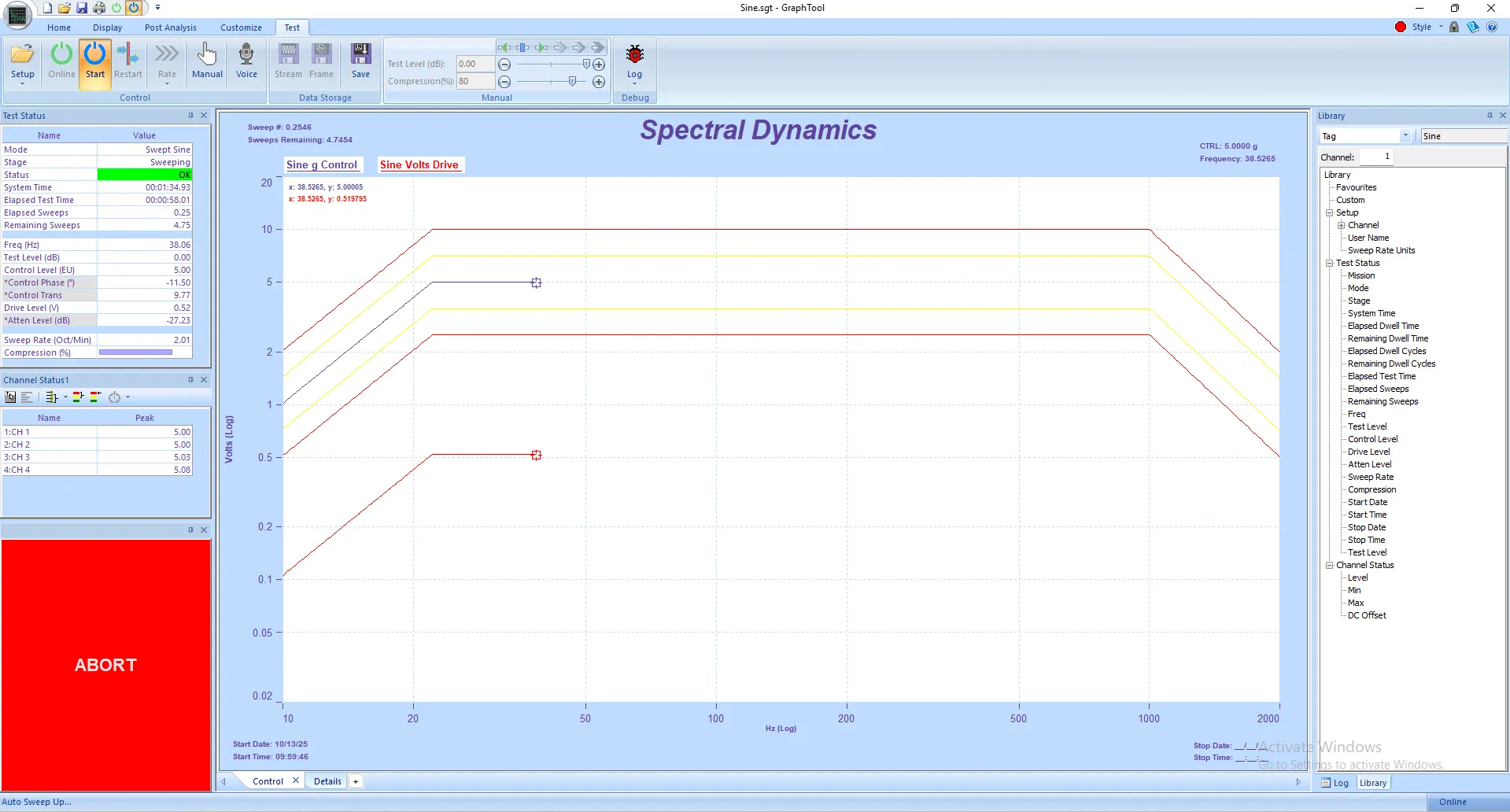Panther Sine Control delivers unmatched precision and stability for both swept-sine and stepped-sine vibration testing. Built on Spectral Dynamics' heritage as the inventor of closed-loop digital vibration control, Panther provides adaptive algorithms, real-time tracking filters, and built-in safety systems that ensure reliable, repeatable results across the full test spectrum. When quality of data is important, Panther sets the standard.

How Sine Vibration Test Works
Panther Sine offers comprehensive test modes for complete system characterization and qualification testing. Engineers can seamlessly transition between swept sine for broad frequency range analysis, stepped sine for precise discrete frequency measurements, resonance search and dwell for fatigue testing at critical frequencies, and sine analysis for detailed transfer function generation. The automated test sequencing capability enables sophisticated multi-stage test protocols with minimal operator intervention.
Easy Setup and Flexible Test Configuration
- Intuitive Library access for instant recall of test setups, profiles, schedules, and historical data.
- Automated test sequencing for Resonance Search, Dwell, Swept Sine, Stepped Sine, and Sine Analysis.
- Modern, touch-friendly interface optimized for Microsoft Surface and Windows PCs with fast configuration and reduced setup time.
- Real-time graphical displays for drive signal, response monitoring, and error tracking.
- Variable sweep rate scheduling with programmable compression control throughout the frequency range.
Advanced Sine Control Technology
- Streaming to Disk — Gap-free, real-time recording of all test data for complete traceability and post-test analysis
- Multiple Data Streams — Independent sample rates for input, control, and drive channels providing maximum flexibility
- High-Performance Tracking Filters — Advanced digital filters guarantee clean response extraction and accurate phase tracking even under noisy test conditions, with better than ±1° phase accuracy
- Swept Sine Control — Adaptive digital control maintains precise drive and response levels across the entire frequency range with logarithmic or linear sweep modes
- Stepped Sine Control — Provides discrete, frequency-by-frequency measurement for detailed system characterization and precise transfer-function generation with programmable dwell duration
- Multi-Loop Control — Simultaneous control of multiple drive loops ensures optimal test stability and repeatability across all control channels
- Resonance Search & Dwell — Automatic resonance detection with programmable Q-value threshold, hysteresis control, and flexible dwell logic for fatigue or qualification testing
- Sine Analysis — Real-time amplitude, phase, and transfer-function computation for comprehensive dynamic system characterization
- Adaptive Error Compensation — Intelligent attenuation-based control continuously compensates for system dynamics point-by-point as frequency changes
- Variable Compression Control — Programmable compression rates from 1-100% with schedule-based automatic adjustment for optimal control through resonances
- Cross-Channel Phase Accuracy — Better than ±1° up to 100 kHz for precise multi-channel measurement and analysis
Profile Management and Test Control
Panther's sophisticated profile management system allows engineers to define control profiles, limiting profiles, and abort profiles with independent alarm and abort tolerances. Profiles support acceleration, velocity, and displacement control modes with automatic unit conversion. The schedule table enables frequency-dependent sweep rates, compression values, and test level adjustments throughout the frequency range. Profile-based limit and abort channels provide multi-channel protection with configurable alarm thresholds in dB relative to the reference profile.
Safety Features for Sine Vibration Test
Panther continuously monitors over a dozen critical parameters up to 25 times per second. Hardware watchdogs, automatic abort thresholds, and redundant safety logic ensure full system protection. Configurable alarm and abort limits with frequency-dependent tolerances protect both test articles and shaker systems. Safety isn't an afterthought — it's designed into the system from the ground up.
Panther Sine: Industry Vibration Test Applications
- Aerospace Vibration Testing
- Automotive Durability & NVH Testing
- Defense & Military Qualification Testing
- Electronics Reliability Vibration Testing
- Transportation & Rail Vibration Analysis
- Energy & Power Systems Vibration Simulation
Technical Data Sheet
|
Input Subsystem |
Output Subsystem |
|
Voltage Ranges: ±12 V to ±0.5 V in 8 steps |
Max Output Current: 16 mA |
|
Auto Ranging: Yes |
Amplitude Accuracy: ±0.20% of value or ±0.03% of full scale (whichever is greater) |
|
Overload Detection: Full scale on all channels; analog and digital detection |
Amplitude Linearity: ±0.20% of value or ±0.03% of full scale (whichever is greater) |
|
Voltage Coupling: AC or DC or GND |
Max Attenuator Rate: Software selectable |
|
IEPE Power: 4 mA (24 V max into open circuit) |
Max Output Rate: 262,144 Samples per Second |
|
Max Rated Input Signal: ±35 Volts Peak |
Image Attenuation: <96dB |
|
Max Sampling Rate: 262,144 Samples per Second |
Frequency Accuracy: ±5 ppm |
|
Sampling Interval: Simultaneous on all channels |
Freq. Range Reduction: 10-stage smoothing filters |
|
Frequency Accuracy: ±5 ppm |
Reconstruction Filters: Analog 1kHz–25kHz, >96dB attenuation, ±0.15dB ripple |
|
Freq. Range Reduction: Digital decimation and filtering using on-board FPGA and DSP |
Output Impedance: 60 Ohms |
|
Input Impedance: 1 MΩ |
Output Type: Pseudo-Differential, 10Ω to Ground |
|
Connection Type: Pseudo-Differential |
Output Cable: Drives up to 50 feet of shielded 50Ω coax |
|
Calibration: Automatic Internal Digital Calibration (NIST referenced) |
Calibration: Internal Digital Calibration (NIST referenced) |
|
TEDS Compliant: Yes (IEEE 1451.4) |
Calibration Constants: Digital Calibration Constants stored in ASCII file |
|
Channel-Channel Match: Phase: Better than ±1.0 degrees to 100 kHz |
COLA Output Level: 1 Volt Peak (post-filter) |
|
Host to Unit Communication: USB / Ethernet / Optional Wi-Fi |
Output Offset Removal Type Accuracy: Better than ±0.5% of Full Scale |
